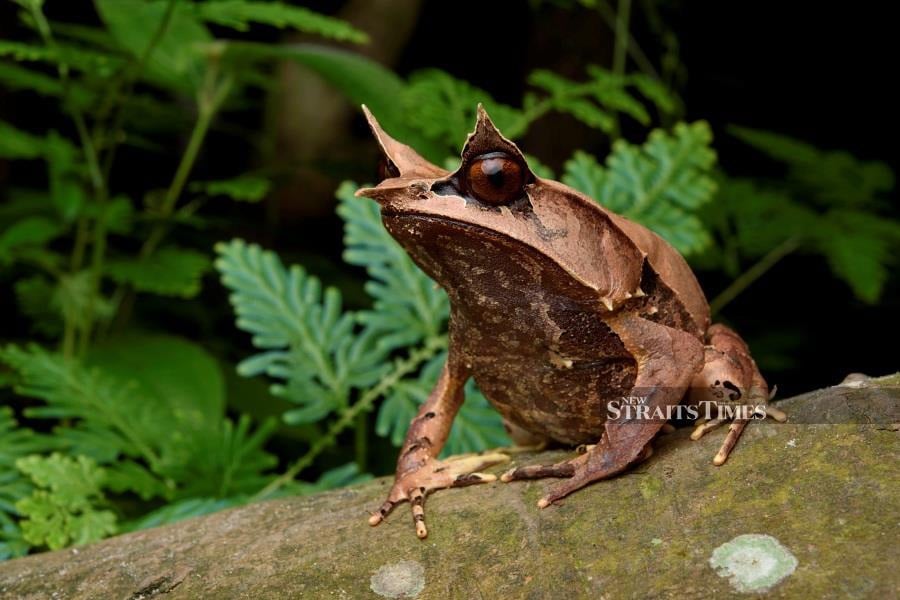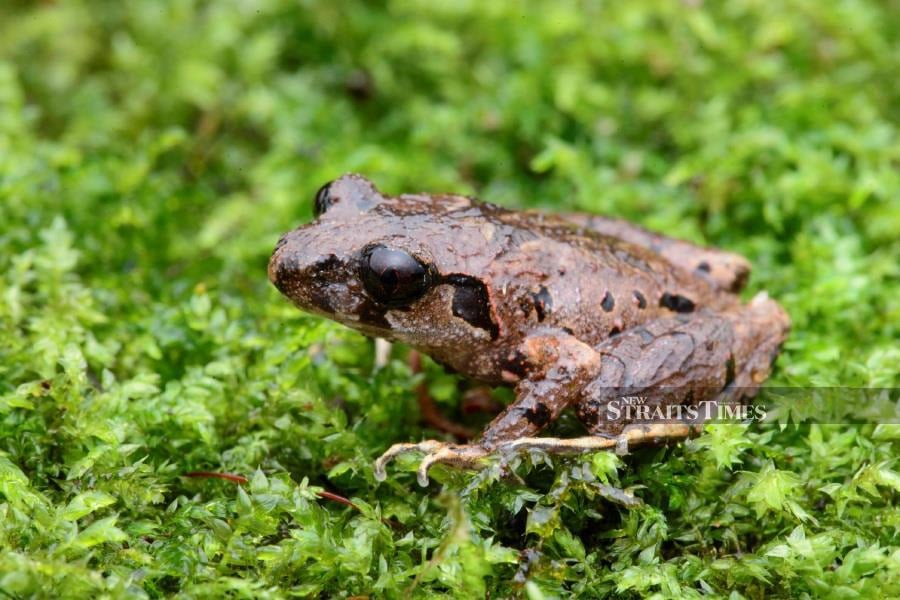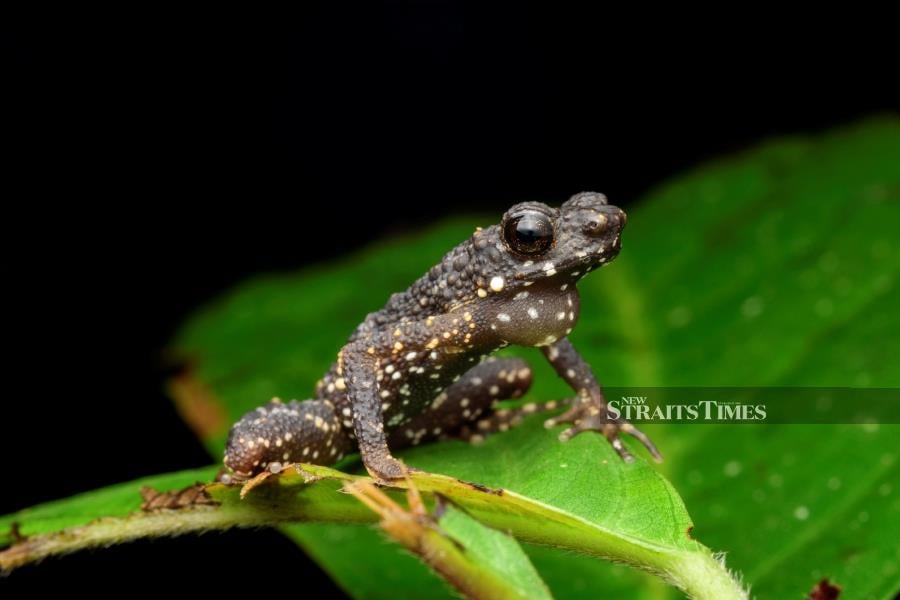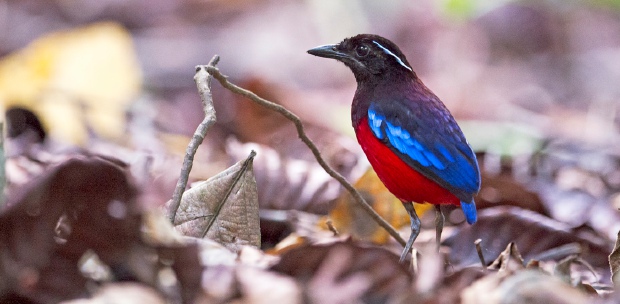IMAGINE diving into the lush jungles of Malaysia, where every leaf and pond teems with life, a place where frogs of all shapes, sizes, and colours leap and croak in harmony. This is the world of Malaysian frogs, a vibrant testament to the country's astounding biodiversity.
Amid this dazzling diversity, here's a fascinating titbit to mull over: All toads are frogs but not all frogs are toads! This intriguing distinction hints at the vast and varied family tree of these amphibians, inviting us to explore and appreciate the intricate web of life that thrives within Malaysia's lush landscapes.
MALAYAN HORNED FROG
(Pelobatrachus nasutus)

THE Malayan horned frog, a master of disguise in the forest, boasts an extraordinary camouflage that mirrors the leaf litter blanketing the forest floor. Its colour and shape are so adeptly aligned with its surroundings that unless the frog springs into action to capture an unsuspecting prey, it remains virtually invisible.
This frog's unique anatomy features an expansive head, a broad mouth and strikingly pointed projections above each eye, enhancing its leaf-like appearance. Emitting a toad-like "honk", it specialises in hunting down invertebrates that dwell on the forest floor, making it a fascinating example of adaptation and survival in the dense forest ecosystem.
WALLACE'S FLYING FROG
( Rhacophorus nigropalmatus)

WALLACE'S flying frog stands out as the most striking amphibian in the region, a distinction it earned upon its discovery by the eminent naturalist Alfred Russel Wallace. As the largest species of flying tree frog found in Malaysia, it sets itself apart from its peers through the unique black webbing stretching across all four of its limbs.
This frog spends the majority of its life in the mid-canopy layer of tropical rainforests, utilising its extensive webbing to glide gracefully from one tree to another. It ventures to the forest floor primarily for mating purposes and to construct its bubble nest.
The frog's back and limbs dazzle in vibrant green, with the sides of its body displaying a stark yellow contrast. Its large eyes, featuring horizontal pupils, add to the captivating appearance of this remarkable species.
SMALL LITTER FROG
( Leptobranchella kecil)

IMAGINE a frog so rare, it lives in an area smaller than your town, only 10 square kilometres! That's the story of the Small litter frog, a tiny amphibian found only in one spot on Earth — Tanah Rata, Cameron Highlands. Scientists have only seen a few of these frogs ever, and they haven't checked on them recently. Because their home is changing a lot due to habitat loss and pollution, no one is sure if these frogs are still hopping around there.
The International Union for Conservation of Nature (IUCN) has classified the Small litter frog as Critically Endangered, which means we're at risk of losing this unique frog forever if we don't take care of its home.
SAFFRON-BELLIED FROG
(Chaperina fusca)

ALSO also known as the Yellow-spotted narrow-mouthed frog, it makes its home in the lush, hilly forests and surrounding lowlands. These frogs have a unique breeding habit, laying their eggs in phytothelms — natural water reservoirs formed in plant crevices, like tree hollows and bamboo sections.
Often found either nestled on the forest floor or perched atop large stones, they aren't shy about climbing rocks or tree trunks to find the perfect spot. They're among the most stunning amphibians, rivalling even the exotic beauty of the Amazonian poison dart frogs!
What sets them apart in the frog world of Southeast Asia is their distinctive colour and patterns. The belly flaunts eye-catching large yellow spots, a signature look for this species. The back's colour palette is more complex, ranging from brown or black to sometimes a greyish hue, adorned with small spots of blue or green. In certain frogs, these spots merge, creating a dominant bluish-grey colour that's truly a sight to behold.
PRECIOUS STREAM TOAD
(Ansonia smeagol)

MEET a real-life character from the world of fantasy: a toad named after Gollum, the unforgettable figure from the Lord of the Rings. Unlike its namesake who roamed the Misty Mountains, this unique amphibian calls the mid-elevations of Gohtong Jaya within the Genting Highlands, its home.
Scientists were inspired to name the toad after Gollum (or Smeagol, as he was originally known) in Tolkien's famed trilogy due to striking resemblances, including its large, prominent eyes, preference for mountainous habitats, long, slender limbs, and notably extended digits.
However, this Precious stream toad's tale is tinged with urgency as its very existence is under threat from habitat destruction. Recognising the peril it faces, the International Union for Conservation of Nature (IUCN) has listed this toad as Vulnerable on their Red List, signalling a call to action to protect its shrinking world.





